Movement of Golf Ball, Impact (Dynamic Mesh), ANSYS Fluent Simulation Tutorial
$100.00 $50.00 Student Discount
- The problem numerically simulates the Movement of a Golf Ball using ANSYS Fluent software.
- We design the 3-D model by the Design Modeler software.
- We mesh the model with ICEM software, and the element number equals 945765.
- We perform this simulation as unsteady (Transient).
- We use the Dynamic Mesh model to define the motion of the golf ball within the domain.
Click on Add To Cart and obtain the Geometry file, Mesh file, and a Comprehensive ANSYS Fluent Training Video.
To Order Your Project or benefit from a CFD consultation, contact our experts via email (info@mr-cfd.com), online support tab, or WhatsApp at +44 7443 197273.
There are some Free Products to check our service quality.
If you want the training video in another language instead of English, ask it via info@mr-cfd.com after you buy the product.
Description
Description
In this project, the movement of the golf ball due to the impact force of 200 Newtons with an angle of 30 degrees has been investigated, and the movement path of the ball has been determined using ANSYS Fluent software. We perform this CFD project and investigate it by CFD analysis.
The present model is designed in 3-D using the Design modeler. The geometry is related to a golf ball placed inside a domain.
The meshing of this present model has been generated by ICEM software. The total cell number is more than 945765.
Also, due to the nature of the present problem, the transient solver has been enabled.
Golf Methodology
In this project, a golf ball movement with an aerodynamic point of view has been studied. The force which is applied to the ball is equal to 200 N. The golf ball displacement due to the impact has been studied in terms of time.
Therefore, to simulate the free motion of the golf ball within the domain, the Dynamic mesh option has been enabled. Due to this motion, the quality of the mesh cells will deteriorate as time passes.
Thus, the smoothing and remeshing sub-models have been enabled to create high-quality mesh whenever the old mesh quality is not suitable for the continuation of the solution. Also, the six DOF options can model all the possible motion types for the golf ball.
Moreover, the SST k-omega model is used to solve the turbulent fluid flow equations due to its advantage in predicting flow patterns near and far from the surfaces.
Golf Conclusion
After the simulation, two- and three-dimensional contours related to pressure and velocity at different flow times are obtained. For instance, as seen in the pressure contour, the front region where the pressure has increased denotes the stagnation point.
In contrast, the rear part where the pressure has decreased indicates the wake region where the flow is separated from the golf ball’s surface.


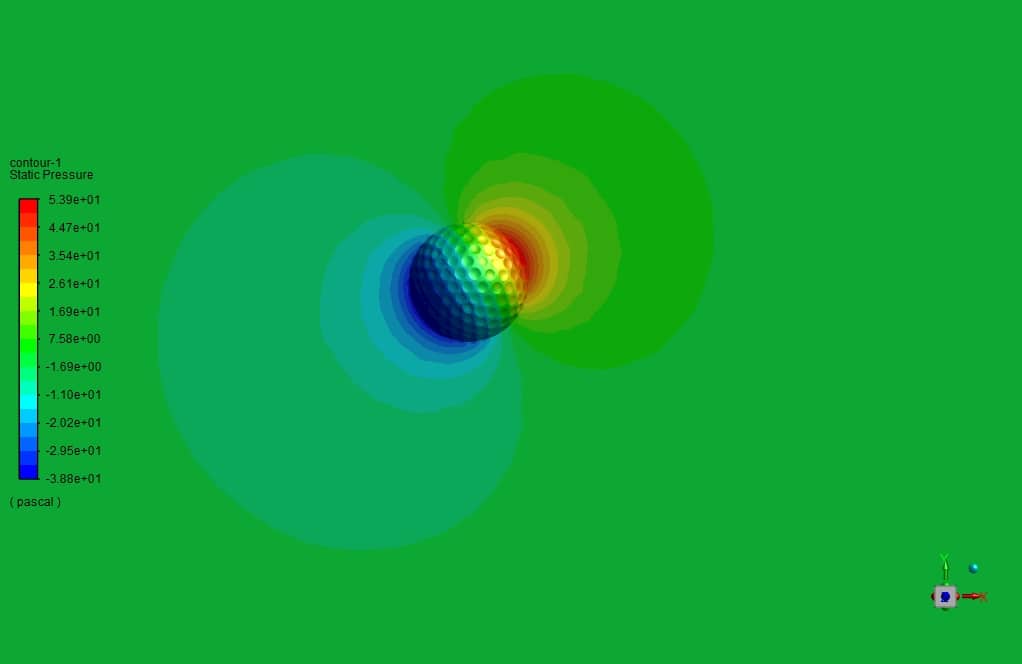
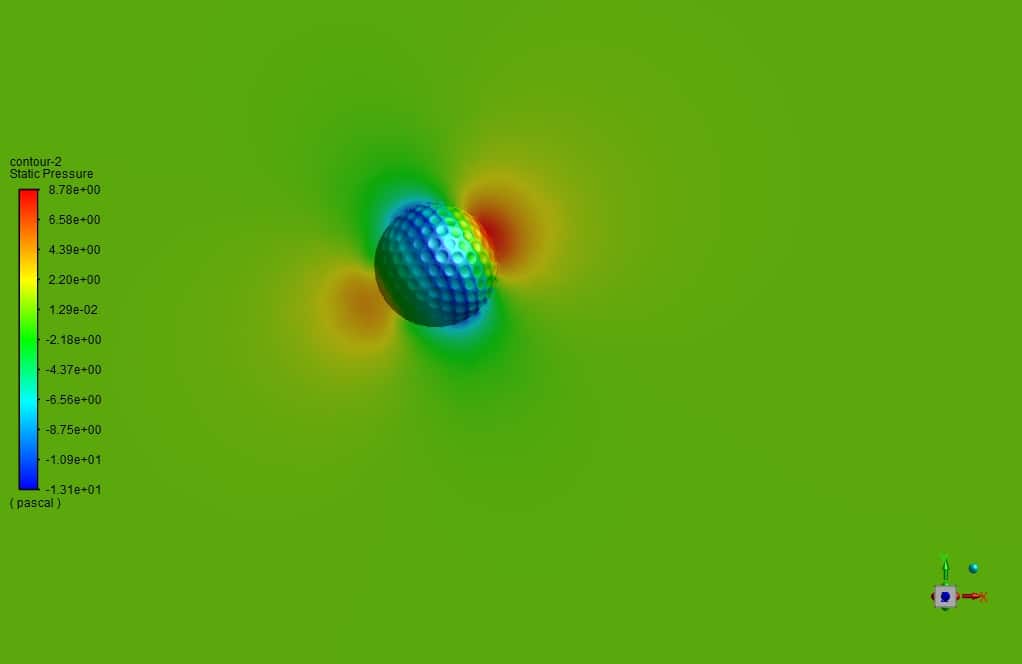

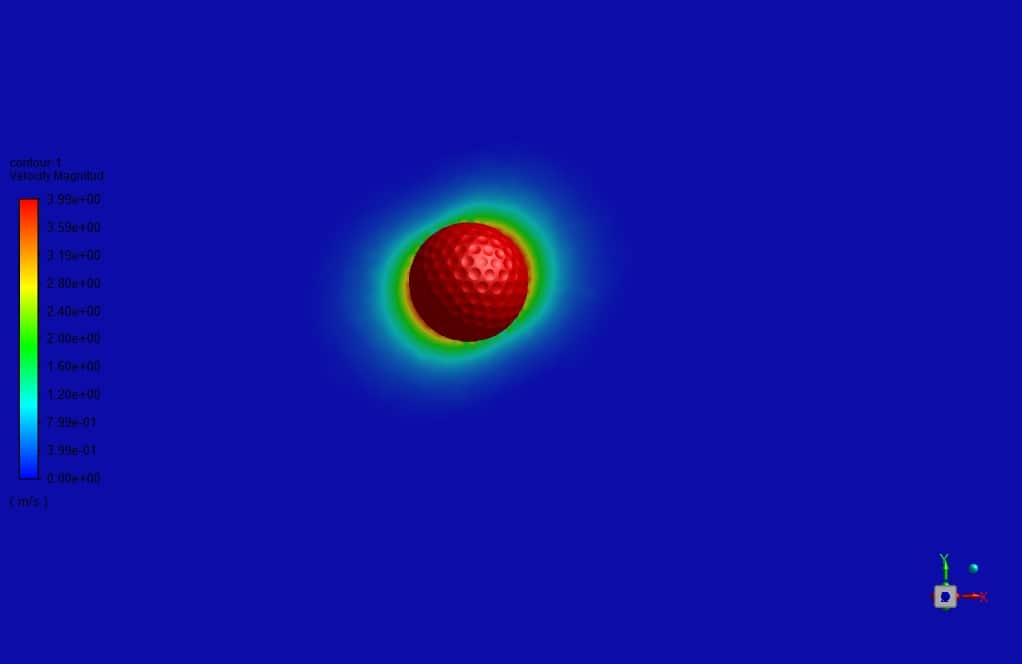
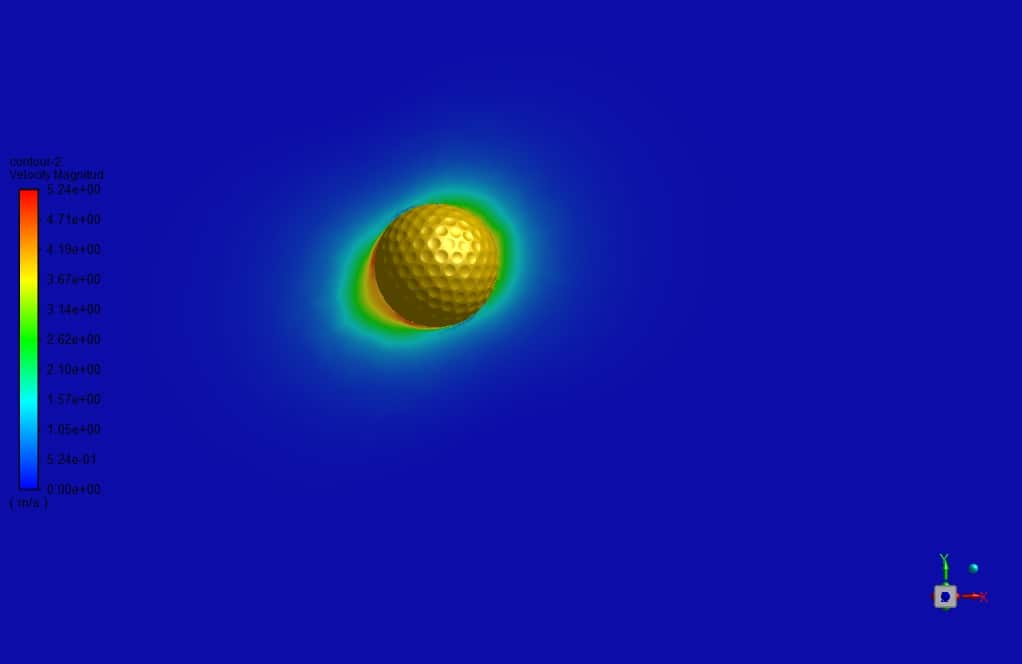
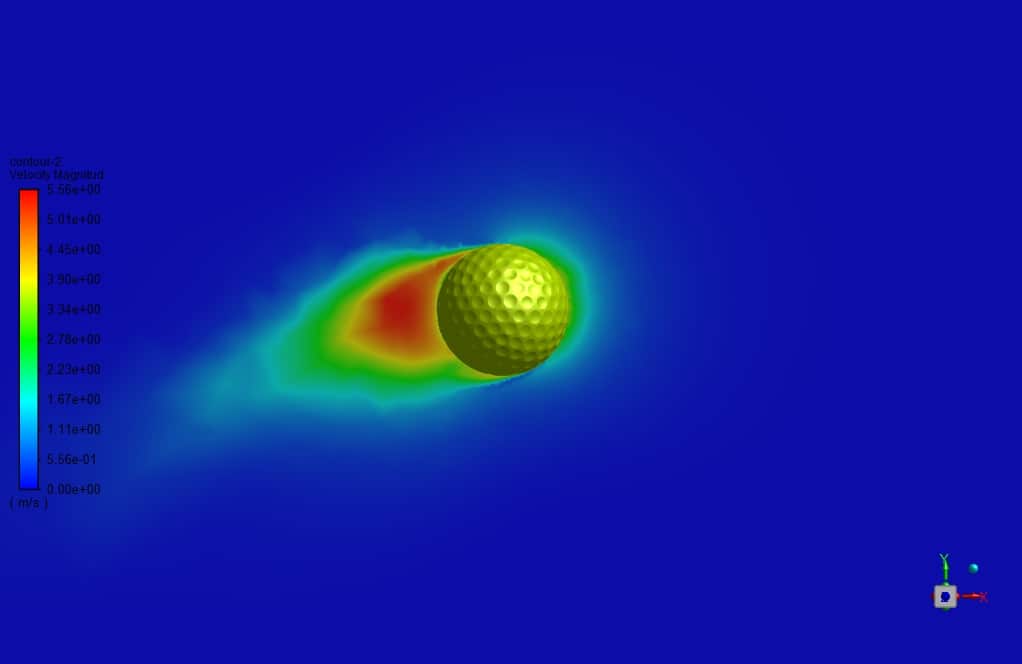

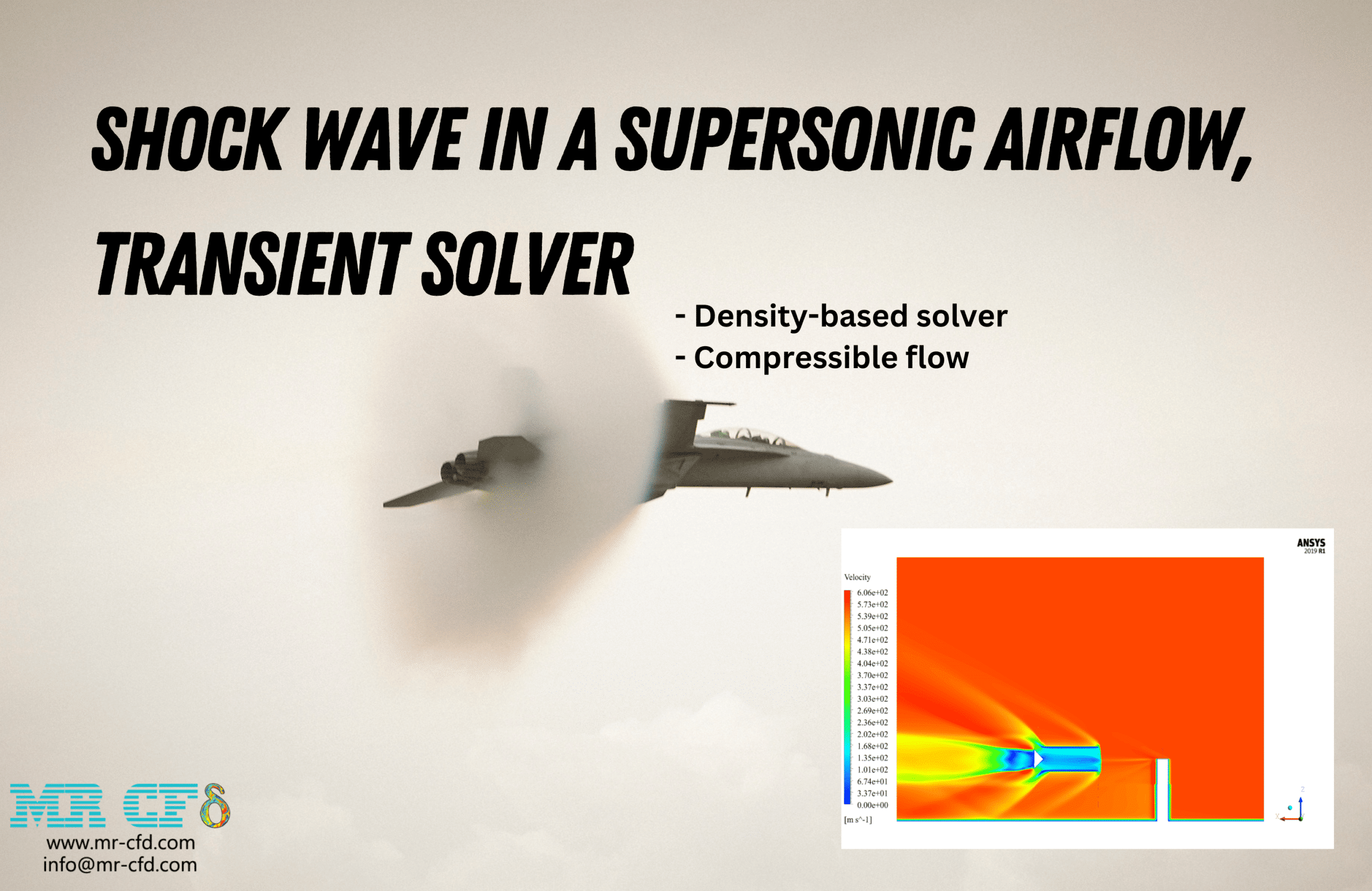
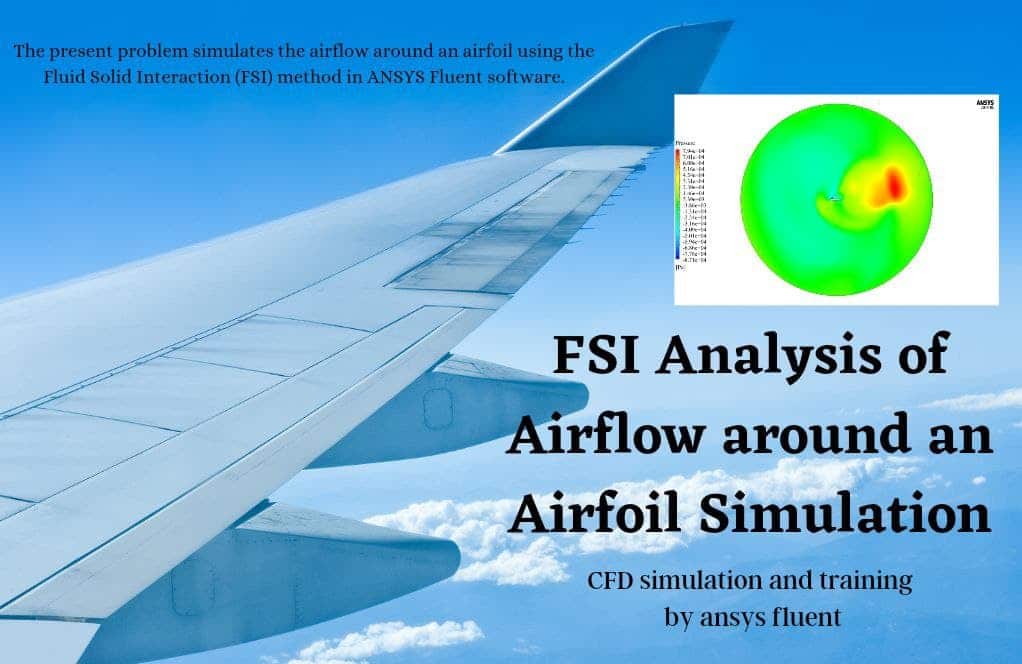
Kayden Feest –
I truly appreciate the comprehensive tutorial on simulating the golf ball’s movement. The dynamic mesh details and the clarity of results make understanding the golf ball’s aerodynamics much simpler. It’s impressive to witness how well the pressure and velocity contours reveal vital flow characteristics like the stagnation point and wake region. Great job on simplifying complex CFD concepts!
MR CFD Support –
Thank you so much for your kind words! We are delighted to know that the tutorial on golf ball movement and the application of dynamic mesh in ANSYS Fluent helped in your understanding of aerodynamics. We always strive to make complex CFD concepts more accessible. Your feedback is very valuable, and we’re glad you found the presentation clear and comprehensive. If you have any more questions or need further assistance, feel free to reach out.
Josue Rippin –
Fantastic explanation of the golf ball simulation! Testing golf ball aerodynamics with ANSYS Fluent can provide very insightful information for design and sports physics.
MR CFD Support –
Thank you for your kind words about our golf ball simulation tutorial! We’re thrilled that you found it enlightening and we hope it contributes valuable insights for those interested in the design and physics of sports equipment.
Lilly Auer –
Does the simulation also take into account the spin of the golf ball often found in real-life scenarios?
MR CFD Support –
The detailed dynamics of the golf ball, including the effects of spin, would be important for an accurate simulation in golf ball analytics. Unfortunately, the current description does not detail this aspect; however, typically, a golf ball’s movement simulation like this, especially if aimed at mimicking real-life conditions, would incorporate the golf ball’s spin. The six degrees of freedom (DOF) define both linear and angular motion, which suggests that the spin could indeed be considered in the analysis if set up in the solver.
Nico Rosenbaum –
The learning materials I received were outstanding! The step-by-step approach made the sophisticated topic of modeling the golf ball’s movements incredibly easy to grasp. Thank you, MR CFD, for a fantastic tutorial!
MR CFD Support –
We’re thrilled to hear that our tutorial on the movement of a golf ball affected by an impact force was clear and easy to understand! Thank you for taking the time to provide your positive feedback. We are committed to providing high-quality CFD learning materials and we’re glad it met your expectations!
Delilah Turner –
I absolutely loved how the tutorial explains the simulation’s intricacies, especially the golf ball’s aerodynamic behavior using the Dynamic Mesh in ANSYS Fluent! Great job!
MR CFD Support –
Thank you for your kind words and positive feedback on the Movement of Golf Ball tutorial. We’re thrilled to hear that our explanations on aerodynamics and the use of Dynamic Mesh in ANSYS Fluent were clear and helpful to you. We always strive to provide high-quality learning materials and it’s rewarding to know we’re on the right track!
Constance Hermann –
The project sounds fascinating! I was curious if you measured how the dimpled structure on the golf ball reduces drag and if that’s part of the simulation?
MR CFD Support –
Absolutely, the dimpled structure’s impact on drag reduction is included in the simulation. The aerodynamic performance in terms of drag and lift forces that the dimples add to the ball’s surface is predicted using SST k-omega turbulence model, and this effect is reflected in the pressure and velocity contours obtained from ANSYS Fluent software.
Lexi Funk –
The tutorial on simulating golf ball movement was comprehensive, and the dynamic mesh explanation was enlightening. The remeshing process to maintain mesh quality during motion was very insightful!
MR CFD Support –
Thank you for your positive feedback on our golf ball movement simulation tutorial. We’re thrilled to hear that you found the dynamic mesh content and handling mesh quality throughout the motion of practical use. Your remarks inspire us to continue delivering comprehensive and insightful learning materials.
Miss Jewel Witting –
The tutorial for the Movement of Golf Ball simulation seems really comprehensive. Learning how to set up dynamic mesh in ANSYS Fluent was insightful, and understanding how the applied impact force and angle affects the trajectory of the golf ball will greatly benefit my own CFD projects.
MR CFD Support –
We’re thrilled to hear that the tutorial was helpful for you! It’s fantastic to know that you found the dynamic mesh setup and the study of impact forces on the golf ball trajectory so insightful. If your CFD projects benefit from our tutorial, that’s a great success for us. Thank you for sharing your positive feedback!
Keagan Tremblay –
This tutorial seems thorough, but could you tell me more about how the six degrees of freedom (6 DOF) model influences the movement and analysis of the golf ball in the simulation?
MR CFD Support –
Certainly! The six degrees of freedom (6 DOF) model is key in accurately representing the golf ball’s motion. It allows the simulation to account for all possible movements of the ball, including translation in three perpendicular axes and rotation about three perpendicular axes. This holistic approach ensures the simulation captures how the ball responds to the impact, including changes to its flight path and spin, which is critical in evaluating the aerodynamic performance.
Prof. Kelvin Keeling IV –
This tutorial sounds comprehensive, but I’d like to know how the initial conditions were set for the golf ball before the impact. Specifically, was it at rest or in motion, and how is that accounted for in the simulation setup?
MR CFD Support –
The initial conditions for the golf ball in this simulation were determined to consider this factor correctly. The ball is initially modeled as being at rest, and the impact forces are then applied to set it into motion. This setup allows for an accurate analysis of the ball’s movement from the moment of impact.
Prof. Leone Bogan V –
What are the key advantages of using Dynamic Mesh and the six DOF options in the simulation of the golf ball’s movement?
MR CFD Support –
The advantage of using Dynamic Mesh in this golf ball simulation is that it allows the mesh to adeptly adjust as the ball moves through the domain, ensuring accurate calculations as the geometry changes. The six Degrees Of Freedom (DOF) option further enhances the simulation by allowing the ball to move freely in all directions and rotate as it would in a real-world scenario, thus providing a comprehensive understanding of the golf ball’s dynamics post-impact.
Keshaun Trantow –
What influence does the six DOF (degrees of freedom) setting have on the simulation of the golf ball movement?
MR CFD Support –
The six DOF setting in the simulation allows the golf ball to exhibit all possible types of motion including translation and rotation in three-dimensional space. It accurately captures the golf ball’s reaction to the 200 N impact force and the subsequent aerodynamic forces acting on it during flight, ensuring a realistic path of motion is computed.
Lela Klocko –
I was amazed by how the golf ball simulation can show the stagnation and wake regions. What makes the SST k-omega model suitable for this golf ball impact simulation?
MR CFD Support –
The SST k-omega model is particularly suitable for this type of simulation because it effectively captures the flow’s characteristics both near the wall and in the far field. This model combines the robust and accurate formulation of the k-omega model in the near-wall region with the free-stream independence of the k-epsilon model in the far field, making it a good choice for simulations where accurate prediction of flow separation, which often occurs in the wake of objects like a golf ball, is important.
Lydia Corwin –
This looks thorough and interesting! Were real-world conditions like wind and air temperature taken into account for this simulation of the golf ball’s movement or is it based purely on the initial impact force and angle?
MR CFD Support –
In this simulation scenario, the primary variables are the impact force of 200 Newtons and the angle of 30 degrees. Environmental factors such as wind and air temperature have not been explicitly noted, suggesting that this particular simulation focuses on the aerodynamics of the golf ball post-impact. However, realistic environmental conditions can typically be incorporated into these simulations to provide a more comprehensive analysis if required.
Dr. Maegan Stiedemann –
I found the project on the golf ball’s movement following the impact incredibly comprehensive. The explanation of how the dynamic mesh was handled to maintain mesh quality over time, as well as the results showing the pressure distributions and flow separations, really provides in-depth insight into the aerodynamic behavior of a golf ball. Well done on a clearly meticulous CFD analysis.
MR CFD Support –
Thank you for the positive feedback on the golf ball movement simulation tutorial. We’re delighted to hear that the presentation of the dynamic mesh adjustments and the simulation results met your expectations and provided valuable insights. Your compliments are greatly appreciated!
Eddie Beahan –
This simulation has helped me to visualize the aerodynamics of a golf ball accurately. It’s quite impressive to see how the forces and turbulence model interact with the golf ball design to impact its trajectory!
MR CFD Support –
Thank you for your positive feedback! We’re delighted to hear that our simulation was able to provide you with accurate visualization and understanding of the aerodynamics involved in golf ball movement. It’s great to know that our detailed CFD analysis met your expectations.
Ms. Cathrine Hodkiewicz V –
The simulation is superb, but I’m curious to know if there’s any observable influence of the golf ball’s dimples on its trajectory or flight behavior in the results?
MR CFD Support –
In our simulation, the effects of the golf ball’s dimples on its aerodynamic properties are taken into account to ensure accuracy in depicting the golf ball’s trajectory and flight behavior. The dimples help reduce drag and improve lift, influencing the ball’s distance and stability in flight. The presented results after the simulation, including two- and three-dimensional contours of pressure and velocity, reflect the interplay of these factors.
Monserrate Jones DVM –
I just finished watching this tutorial, and wow, I was impressed with the simplicity in showing how to set up the dynamic mesh to model the golf ball’s movement. Great stuff!
MR CFD Support –
We’re thrilled to hear you found the tutorial impressive and easy to follow. Thank you for your positive feedback, and we’re glad it enriched your understanding of setting up dynamic meshes in ANSYS Fluent. If you have any more questions or need further assistance, feel free to ask. Your success is our top priority!
Brendon Kautzer –
What specific features of the SST k-omega model make it suitable for predicting the flow patterns around the golf ball in this simulation?
MR CFD Support –
The SST (Shear Stress Transport) k-omega model is ideal for this scenario as it incorporates the best attributes of the k-omega and k-epsilon models. It accurately captures the near-wall boundary layer effects and transitions seamlessly to handle the free stream effects away from the surfaces, which is crucial for simulations involving aerodynamic bodies like golf balls where both near-wall and far-field flows are important.
Ms. Cecilia Beahan Jr. –
This golf ball simulation is stunning! Can see how fluid dynamics principles are applied so precisely!
MR CFD Support –
Thank you for your kind words! We’re elated to hear that you appreciate the precision and application of fluid dynamics in our golf ball impact simulation tutorial. If you have any further feedback or require assistance with another CFD project, feel free to reach out!
Felton Zboncak –
The tutorial was incredibly informative, especially the clarity around the dynamic meshing techniques and DOF settings. I am fascinated by how the SST k-omega model significantly improves the prediction of complex flow patterns. How well did the results correlate with experimental or real-world data, if available?
MR CFD Support –
Thank you for your kind words regarding our golf ball dynamics simulation tutorial. As for the correlation with experimental data, in CFD projects, validation is a critical step. Although this review may not show the validation process, typically, our results are compared against experimental benchmarks or high-fidelity simulations to ensure accuracy. The results from this simulation should align reasonably well with real-world data, given that the proper physical conditions were modeled, and high-resolution meshing was carried out. These correlations help in strengthening the confidence in the simulation outcomes.
Alessandra Crist –
The tutorial sounds comprehensive, but could you detail how the six DOF option contributes to tracking the golf ball’s path more realistically?
MR CFD Support –
The six DOF (Degrees of Freedom) feature incorporated in ANSYS Fluent allows the simulation to capture all possible movements of the golf ball, which includes translation in all three spatial directions and rotations around three axes. By using this feature, the simulation accurately reproduces how an actual golf ball would move when struck, taking into account the applied force as well as the ball’s reactions to the surrounding fluid forces.
Prof. Elmer Paucek –
I was really pleased with how clearly the tutorial explained the handling of dynamic mesh settings. The visualization of changing pressure contours on the golf ball was fascinating. Great job!
MR CFD Support –
Thank you for your positive feedback! We’re thrilled to hear that the dynamic mesh handling and pressure contour visualizations were clear and engaging. If you have any further questions or need guidance on similar simulations, don’t hesitate to reach out!
Mrs. Taryn Goyette –
I’m impressed with the dynamic details captured in this simulation. Is there a specific reason why the SST k-omega model was chosen for predicting the turbulences over other models?
MR CFD Support –
Thank you for your compliment on the simulation detail. The SST k-omega model was chosen because it offers a balance between accuracy across the flow field and computational efficiency. It’s capable of accurately predicting the boundary layer flow, which is crucial in simulations involving aerodynamic applications such as the movement of a golf ball. Furthermore, it performs well in adverse pressure gradients and separating flows, which are common in sports aerodynamics.
Sigmund Krajcik –
Is it possible to observe the real trajectory and spin behavior of the golf ball from the results?
MR CFD Support –
Yes, the simulation includes dynamic mesh and six degrees of freedom (DOF) capabilities, which when combined with transient analysis, accurately capture the real trajectory, rotation, and spin behavior of the golf ball post-impact.
Santiago Borer –
I was really impressed with the detail in the golf ball simulation tutorial. I’m curious, how were the results validated against actual physical phenomena or existing research to ensure accuracy?
MR CFD Support –
Thank you for your appreciation of the tutorial’s detail. The simulation results are often validated by comparing them to experimental data or empirical correlations established in prior research. We ensure that the simulation parameters are set realistically, and the outcomes like pressure distribution and flow patterns are benchmarked to observed behavior in golf ball aerodynamics studies or practical experiments.
Citlalli Goodwin –
The tutorial was clear and useful. It added a practical perspective to my CFD coursework for capturing dynamic golf ball motion.
MR CFD Support –
Thank you for your kind words! We’re thrilled that our golf ball movement simulation tutorial was helpful and added value to your coursework. If you have any further questions or need more guidance, feel free to reach out!
Ms. Madie Heathcote III –
I followed the golf ball movement tutorial and the results are fascinating. I’m curious about how the six degrees of freedom (6 DOF) impacts are accounted for during the simulation setup.
MR CFD Support –
In the simulation setup, the six degrees of freedom (6 DOF) option is utilized to account for the golf ball’s free movement within the domain. This includes translation in three orthogonal directions and rotation about three orthogonal axes. The force and moment coefficients calculated from the fluid flow simulation influence the golf ball’s trajectory and angular motion over time, accurately depicting its impact and subsequent flight path in the fluid domain.
Mr. Lamont O’Reilly PhD –
I’m intrigued by the use of the Dynamic Mesh in this simulation, especially the mechanisms of smoothing and remeshing. Can you explain how the quality of the mesh is maintained throughout the golf ball’s motion?
MR CFD Support –
During the CFD simulation of the golf ball’s motion, maintaining the mesh quality is crucial as the ball’s position changes over time. The ‘Dynamic Mesh’ method incorporates ‘Smoothing’ to adjust existing mesh nodes within their element boundaries, enhancing mesh quality without altering the number of cells. ‘Remeshing’ is utilized to regenerate and refine the grid where necessary based on predetermined quality criteria thresholds. This ensures that, regardless of the ball’s motion or deformation of the computational domain, the mesh adapts dynamically, sustaining the solver’s accuracy and stability.
Nedra Rohan –
The dynamic mesh’s smoothing and remeshing sound essential for this simulation. Can you explain how it works?
MR CFD Support –
Sure, dynamic mesh’s smoothing and remeshing are crucial techniques that adapt the mesh as the simulation progresses over time. Smoothing adjusts mesh node positions to prevent poor-quality elements without changing mesh connectivity, while remeshing generates new cells to replace distorted ones. This ensures high-quality mesh throughout the simulation, which is necessary for accurate results in cases like the movement of a golf ball under impact.
Ardella Batz –
Out of curiosity, can this simulation show what would happen if the angle of impact changed or if a different force was applied to the golf ball? It would be intriguing to see how different variables affect the ball’s path.
MR CFD Support –
Absolutely, this simulation has the capability to adjust and analyze various hypothetical scenarios including changes in the angle of the golf ball’s impact or different magnitudes of force applied. By altering these input parameters, one can examine the subsequent effects on the golf ball’s trajectory, speed, and the flow separation patterns around the ball, providing insights into the physics of golf ball aerodynamics. These changes can be explored within the Carbon Dynamic Mesh toolbar Zator options in ANSYS Fluent to observe how the golf ball reacts to different forces or impact angles.
Cornell Bins –
I am thoroughly impressed by how the golf ball’s trajectory was determined with the dynamic mesh and the impact force details. It was fascinating to see the six degrees of freedom model in action, which results in-deep realism in terms of aerodynamics. Definitely upped my CFD game!
MR CFD Support –
Thank you for your positive feedback! We’re delighted to know that our tutorial on the golf ball’s movement and the dynamic mesh technique enhanced your understanding of aerodynamics in computational fluid dynamics. We are committed to providing informative and realistic simulations, and it’s heartening to hear about the positive impact on your CFD experience.
Hertha Harris –
I thoroughly enjoyed learning about dynamic mesh and six DOF through this tutorial. The visual materials helped me understand the concepts much better. Great work producing a comprehensive guide on such a complex topic!
MR CFD Support –
Thank you for your kind words! We are thrilled to hear that our tutorial on the ‘Movement of Golf Ball, Impact (Dynamic Mesh), ANSYS Fluent’ was insightful and that the visual aids contributed positively to your learning experience. If you need further assistance, feel free to reach out.
Cooper Gutmann –
The explanation of the simulation is quite fascinating. Could you please elaborate on how the mesh quality was ensured throughout the golf ball’s motion in the simulation?
MR CFD Support –
To ensure mesh quality throughout the golf ball’s motion, the dynamic mesh technique involving smoothing and remeshing sub-models was utilized. Whenever the quality of the mesh cells deteriorated due to the movement of the golf ball, these sub-models would dynamically adjust, refine, and optimize the mesh to maintain a high level of integrity conducive to accurate simulations of the fluid dynamics around the moving ball.
Dallin Jenkins –
This is an excellent resource for understanding the aerodynamics of a golf ball. Great work on describing the force application and the resulting movement. Thanks!
MR CFD Support –
Thank you for your kind words! We’re glad to hear that you found the simulation tutorial for the golf ball’s movement insightful. If you have any further questions or need assistance, feel free to reach out. Your feedback is much appreciated!
Prof. Chanelle Watsica I –
I am thrilled by how the movement of the golf ball was captured! Could you elaborate on how the Dynamic Mesh technique maintains mesh quality during the simulations?
MR CFD Support –
Thank you for your positive feedback! In response to your inquiry, the Dynamic Mesh technique utilizes algorithms designed to adjust the mesh as the golf ball moves. The ‘smoothing’ operation redistributes the mesh points smoothly in motion-affected areas to prevent excessive distortion. Whereas ‘remeshing’ replaces this deteriorated mesh with a new one that can better accommodate the current position and shape of the golf ball, maintaining an optimal mesh quality throughout the simulation.